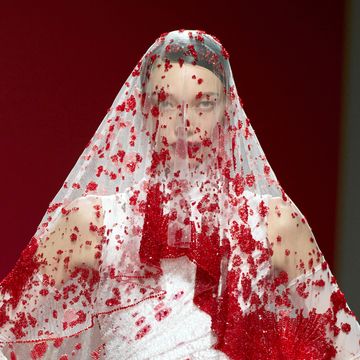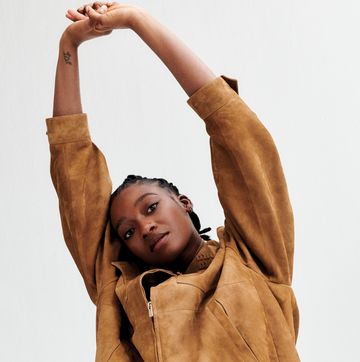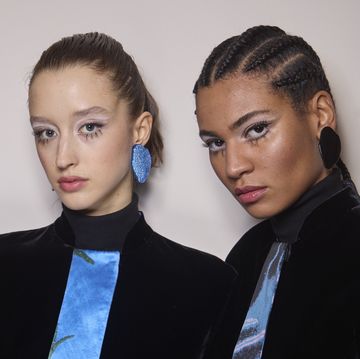When Kim Jones was creative director of Louis Vuitton menswear in the 2010s, he lived in Paris, where he’d find himself going to the Yves Saint Laurent store most Saturdays (back before the brand’s name was shortened to Saint Laurent.) It was a relatively buoyant, feel-good time for fashion. A time when much of the Western world was climbing out of a global recession; easing into a period of spending, smart phones, and social media; and settling into the era of Beyoncé and Taylor Swift. ‘I only wore Saint Laurent clothes at that point – apart from the things I made myself,’ he says.
Jones was a fan of the creative director at the time, Stefano Pilati, a man who to this day is viewed as a designer’s designer, revered by many of the industry’s most revered talents. ‘He was always one of my favourites,’ Jones says, before recalling Pilati’s autumn/winter 2009 YSL collection, a leather-filled exercise in rigour and sensuality with boyishly sexy shirts, dresses, moto jackets and jumpsuits, which Jones includes on his shortlist of top runway shows ever. Why? ‘Everything was perfect and in place – the music, the set, the hair, the make-up, the clothes,’ he says. ‘He captured a moment in time.’
Many could say the same of Jones, who was solidifying his status as the menswear world’s brightest star, creating sell out collections that struck a then-novel balance between impossibly cool streetwear and luxurious tailoring. He had become that rare designer who not only chronicled a culture, effectively pulling the world of the hypebeast into luxury fashion’s gilded halls, but popularised a shift in tone that would reverberate throughout the industry for years to come.
Since then, Jones has become a man with an ever-growing list of superlatives: he is the most powerful British designer working today, as creative director of menswear for Dior and womenswear and couture for Fendi. He is also among the country’s most garlanded designers, with an Order of the British Empire, multiple British Fashion Awards and a recent ELLE Style Award for Designer of the Year 2023, to name a few. Jones might not have the kind of household name recognisability that reaches far beyond the fashion grid, like his Fendi predecessor Karl Lagerfeld, or friend Donatella Versace. But very few designers working now enjoy the level of influence he has.
At 44 years old, he has been working long enough now to grow contemplative about his place in the industry, the responsibility he has to it and the kind of legacy he wants to build, which is in part why he is here talking to me about his new collaboration with Pilati, the latest in his Friends of Fendi series, which the brand describes as a group of projects and collections intended to cross ‘the party lines of the fashion industry’ and prioritise ‘sincerity over strategy, with a true notion of friendship at its heart’.
Fashion is more of a collective practice than, say, painting or writing, which tend to be more solitary artistic pursuits. Behind every designer is an atelier full of petites mains who bring the vision to life, not to mention a support network of friends and peers who serve as sounding boards. But Jones has turned the idea of collaboration, and shared creativity, into an art form, having instigated some of fashion’s most memorable and unexpected unions,including legendary creative partnerships with Supreme and later Dinos and Jake Chapman at Louis Vuitton, as well as Kaws, Peter Doig and Tremaine Emory at Dior.
This sense of yin and yang seems to be a recurring thread in Jones’ life. He’s a streetwear enthusiast who has amassed one of the largest private collections of books about the Bloomsbury Group in the world. He’s a designer who sits atop two of luxury fashion’s most prestigious brands – and a dedicated wildlife conservationist. He’s a pragmatic dresser prone to trainers and jeans – with a magpie’s eye for jewellery. He’s a master at exploding the idea of binaries, and changing what we regard as high or low.
Throughout our conversation, which takes place on Zoom after a bout of Covid (ahem, me) prevented us from spending an afternoon together at his house as originally planned, I’m distracted by the enormous yellow and white diamond rings on his hand, stones the size of actual rocks that practically jump off the screen. ‘Oh, these are just treats. I like to reward myself when I work hard,’ he says.
His friendship group is just as shiny and glittery: the Supers! Hollywood! But despite all the celebrity, all the media coverage of his connections to Kim Kardashian, Kate Moss, Demi Moore and Marc Jacobs – all the photo-ops with the Donatellas, the Courtney Loves and the Lily Allens – Jones has a humble, low-key demeanour, which might be why he’s so incredibly well-liked. He’s thoughtful, sending messages to check in on me and see how I’m recovering, and funny, with a dry sense of humour.
Most of his collaborations were borne out of his friendships and a desire to share his platform with peers he admires, as with his Fendi x Skims collection that launched in 2021. ‘You know, all the girls here are obsessed with Skims. And so I was just like, “Well, why don’t we work with them?” What I respect about Kim is how hardworking she is,’ he explains. And then there was his highly anticipated work with Donatella – Fendace – in 2022, in which he designed a collection for Versace and Donatella created one for Fendi. ‘Who doesn’t love Donatella?’ he asks. ‘She’s one of the best people in the world. The Queen of Italy, so to speak. And that was just really fun. I was, like, pleasing my teenage self, working with all those models, and with Versace and the codes,’ he says. When he invited Marc Jacobs, famous for his eponymous brand but also for his time as women’s creative director of Louis Vuitton, he says he viewed it as a show of respect. ‘And I love the collections Marc’s been doing recently, and so I thought it’d be nice to see more of it,’ he says.
Jones says his reasons for collaboration are also pragmatic, in a field in which designers pull inspiration from everything and everyone: ‘Rather than take something and replicate it, or copy it, I think just work with the people. And all these people have been my friends and been in my upbringing for the last 20 years. For example, the Supreme thing. That was something I wore as a teenager. Watching Stefano present his collection was really exciting, because it’s inspirational. These things all mean something.’
But he’s also clear that collaboration is only a small part of his very outsized output. ‘You know, you work on a lot – two big houses, 22 collections a year. And maybe four have different people in them,’ he says. His ability to multitask is now the stuff of legend, rivalling only Lagerfeld, fashion’s most famous polymath. Jones keeps his collections apart by ascribing a soundtrack to each, which he listens to as he works, to help keep him in the desired headspace.
‘People always go, “You just collaborate with people.” I don’t actually, because there are a lot of other collections where we don’t. But at certain points I want to work with people because I think it’s interesting, a conversation. And teaching younger generations about the amazing designers they might not know is also a great thing. Fashion is so fast. Now people only really think about the last six months. And so they don’t think about anything before that. I think that you have to remind people how great certain people are,’ he says.
That brings us back to Pilati, who stepped down from his role at Yves Saint Laurent in 2012, four years before the birth of TikTok, and eventually relocated to Berlin and launched his own label, Random Identities. Pilati’s impressive CV includes early roles at Giorgio Armani and Prada before big post-YSL creative director jobs at Ermenegildo Zegna and Agnona. Nevertheless, to many younger millennials and Gen Z, he’s a lesser-known entity. ‘This is a coming together of two worlds and I am so touched by the opportunity that Kim, Silvia and Fendi have given me to be so much myself while exploring theirs, the world of Fendi,’ Pilati says. ‘I thought about how my style could fit into Fendi and yet I needed to stay true to myself. It’s one of the reasons I wanted to start with tailoring – it is one of my strongest skills,’ he says.
'I wanted to work with Stefano because he’s someone who has such a great voice in fashion, and just celebrate him,’ Jones says.‘He really understands and lives luxury,’ Jones adds. ‘That’s the thing for me with him – the precision, the idea, the concept. It’s amazing to watch.’
The collaboration began with a visit to the Fendi archives for Stefano, and stands out for its play with the rapidly changing ideas of masculinity and femininity. ‘It’s very 60s Warhol Factory almost, in the sense that it was mixing things up; so it’s not just the men’s and women’s, there’s a crossover,’ Jones says. Pilati adds: ‘It is a question of defining things now. Being open to new ways of defining is important both for the clothes and the attitude.’
The collection is filled with classic Pilati tailoring (elegant louche suiting that mixes masculinity and femininity) and easy evening wear, and will land during a very different time from the period when Jones first fell in love with Pilati’s work. There are the cost of living and climate crises, in addition to ever-rising geopolitical tensions. The day Jones and I speak, runway images from Paris Fashion Week have given way to devastating footage of war.
‘We have to be very aware of what’s going on in the world. For example, we’re in Rome in mid-October and it’s 32 degrees outside.And then there is what’s happened in the last few days with the war [in Israel and Gaza] as well. So you have to keep going, but you have to have a conscious eye on how you express yourself to the world,’ he says. He has limited his use of Instagram. ‘There’s just so much negativity and I don’t want this feed of depressing things when I’m trying to create something. I can’t be a big political spokesman, because it’s not my job. I don’t know enough about politics. But I have to be thoughtful about what we’re doing for the next generation,’ he says. That impulse drives his work as a conservationist, a passion that stems from a lifelong love of wildlife.
Jones wanted to be a zoologist as a child. ‘And then my mum died when I was very young, and I didn’t want to study so hard,’ he says. So he pursued fashion, ‘which is probably the hardest work you can imagine’, he says with a wry laugh. ‘But at least you get paid well, so that you can do all these other things. So I go around the world and work with species that number fewer than 500 or 1,000 in the world, doing projects to help preserve them,’ he says. His work spans the douc langur, a monkey native to Vietnam, Cambodia and Laos, and the kakapo, a parrot found in New Zealand. ‘It’s a pleasure to help keep these species going,’ he says. Travel has been a prominent part of Jones’ life since he was an infant. He took his first trip to Ecuador with his father, a hydrogeologist, and mother, at three months old, before living in a string of countries including Kenya, Botswana and Ghana. But now, he tries to stay in his west London home as much as possible, which he finds grounding, spending time with his tight inner circle of collaborators including Simon Parris, music and creative partnership consultant who has known Kim since he was four, and Lucy Beeden, the design director of his studio, who has worked with him for 18 years. ‘People think of me and they probably think I’m a bit of a machine, which I can be when I’m working. But I’m the most human of people as well,’ he says.
After he leaves Rome he’ll head back to London, where his sprawling collection of books and art awaits. But in true Kim Jones style, he intends to share it. ‘I bought the old school next to Virginia Woolf’s house [as somewhere] to put my collection of books, which is probably near 1,500 now – for scholars and students to study, but also to be there for people to see them,’ he says. He views himself as more custodian than collector. ‘You’re never going to stay alive forever. So when I’m doing this collecting, there is a thread of looking at where these things go[in the long-term]. I’m a very practical, boring Virgo in that sense.And it’s nice to think: you’ve achieved this, you’ve earned this, you can protect it and keep it and put it together.’
This article was originally published in the December issue of ELLE.


















